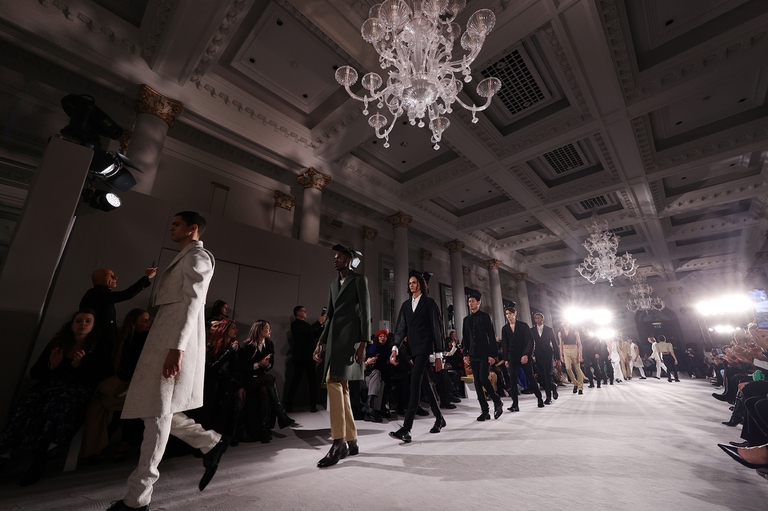https://www.lifegate.it/impatto-ambientale-fashion-week-settimana-della-moda
- |
- During Fashion Month, the combination of the four most important fashion weeks in the world, 241 thousand tons of CO2 are emitted.
- It is necessary to seriously reflect on the future of events such as Fashion Weeks in a historical moment in which the protagonists of the system themselves want to change it.
- The Helsinki and Copenhagen Fashion Weeks were trailblazers in this sense, but the National Chamber of Italian Fashion has also started a path towards a greener future for quite some time now.
Keeping the Eiffel Tower lit up for three thousand years, or the entire Times Square for 58, has more or less the same environmental impact as Fashion month, or the combination of Fashion week of the most relevant cities for the world of fashion: Paris, Milan, New York And London.They are indeed 241 thousand the tons of CO2 issued during Fashion Month according to Zero to market, a 2020 study carried out by the fashion tech company Order.
Written in collaboration with Carbon trust, the research produced this result by adding the annual emissions of all transport, which constitute an integral part of the process wholesale purchase, and measuring the carbon footprint beyond seven thousand people including buyers and designers who regularly participate in the four Fashion Weeks examined.

The carbon footprint of Fashion Weeks
“The emissions calculated by Carbon Trust in the report are only a marginal part of the carbon footprint of the fashion industry.However, the research provides a significant image of the impacts of the sector on carbon emissions which, given the data, could positively influence the stakeholders of the fashion system and lead them to make more informed choices, professionally and personally", he argues Leonardo Boeri, business development executive for Southern Europe of Carbon Trust.
“To reduce the environmental impacts of this type of event we should aim to reduce travel emissions, preferring the train to the plane when possible and opting for the use of electric vehicles.To avoid traveling around the city, dedicated hubs could be established and events planned there, while as regards scenography it would be good practice to reduce the production of disposable materials to a minimum, first and foremost avoiding non-recyclable equipment and encouraging the shared use of venues and venues for performances during the week”.

There are many aspects to take into consideration
Ordre's estimate is just the tip of the iceberg:in addition to buyers and stylists, there are also journalists, models, photographers, make up artists, hair stylists, fitters, international guests and many others traveling between the various locations.Not only that:events such as Fashion Weeks involve a massive movement of people even within individual cities to reach the shows, which are held in different locations and which, by their very nature, have a very high energy requirement;just think of the lights used for each individual catwalk and the displays, often created ad hoc.
“Ordre's study focused above all on the movements of workers: accurately measuring the carbon footprint of one or more Fashion Weeks is very complex because a lot of data needs to be considered, for example:how many people actually participated, the transport they used to reach the events, energy consumption, catering, waste generated as well as all the activities involved, from preparation to dismantling.Furthermore, we are talking about a sector, that of fashion, in which the measurement of emissions is already particularly complex in itself due to the breadth and variety of the production chains of the processes", he adds Andrea Maggiani, founder and CEO of Carbon sink, a company specializing in climate strategies that recently joined the international South pole group.
Fashion weeks, as we know them, are events that we can no longer afford from an environmental point of view.Ordre's research, however partial, clearly highlighted this already in February 2020, a few weeks before the outbreak of the health emergency linked to the COVID-19 pandemic. COVID-19, just a moment before the global confinement imposed the forced stop of any event.In the two years in which the in-person fashion shows were very few and limited and alternative methods were experimented, such as digital shows, it seemed that it could somehow be found to drastically reduce the energy expenditure linked to at least this aspect of the fashion system, but two years later and the restrictions ended, little has changed in reality.

The Helsinki and Copenhagen model
There climate crisis however it is still there and requires us to seriously reflect on the future of events such as Fashion Weeks in a historical moment in which the protagonists of the system themselves want to change it.At a time when brands and designers are rethinking their business to become more sustainable, it seems like a mistake not to do the same with fashion shows.Things need to evolve, but is there a better, greener alternative that actually works?The Fashion Weeks were trailblazers in this sense Helsinki And Copenhagen, but also the National Chamber of Italian Fashion (Cnmi) has been on the path towards a greener future for some time now.

The Helsinki event was the first to propose itself and be recognized as sustainable thanks to three fundamental key principles:attention to production right from the embryonic design phase, involvement of designers who satisfy certain sustainability criteria and, last but not least, the environmental assessment of the location chosen for the shows, which translates into examining how much water and energy are used and possible recourse to renewable energy sources, such as wind and solar.As regards the food offered during the event, the indication is to give preference vegan menus And seasonal ingredients.
As regards the Copenhagen Fashion Week, however, starting from 2023 the brands that intend to participate will necessarily have to satisfy certain sustainability requirements.Designers will be able to earn points based on their design practices, working conditions and production of the show or presentation, and if they do not meet a minimum threshold they will be deemed ineligible to participate.

The green initiatives of Milan Fashion Week
For Italy the issue is slightly more complicated, both due to the importance of the brands present in the calendar and the shape of the city itself, but the CNMI has started to put initiatives on the agenda for a more sustainable change in the sector starting from 2012, when the Manifesto for the sustainability of Italian fashion which immediately saw over two hundred brands involved.“Since then, periodic initiatives have followed such as technical working groups, publication of documents and guidelines for the entire sector and training events aimed at designers,” explains the president Carlo Capasa.“As for the Milan fashion week, for several editions we have given space to brands focused on the theme of sustainability, planning ad hoc sections within our week of shows and our Fashion hub.We have been hosting for five years Designer for the Planet, an event in which five brands, whose work is based on rigorous environmental sustainability criteria, present their collections”.
Furthermore, as regards social sustainability, during this edition a new space will be inaugurated within the Fashion hub: Designer for ethical fashion, dedicated to the theme of ethical and social fashion with particular attention to disadvantaged women, victims of violence, immigrants and refugees.Finally, all the Cnmi spaces, such as the Fashion hub and the presentation room, have been set up with recycled and reused materials and, in recent years, we have switched to solo digital accreditation, eliminating paper to reduce paper waste.“Aware of the pollution resulting from travel, we have maintained and implemented our digital platform that allows follow the Fashion week around the world remotely.The push on digital was given by the pandemic, but we believe it has become an essential tool also with a view to sustainability and inclusion”, concludes Capasa.

A glimpse into the Italian fashion and luxury sector
In April 2021, Carbonsink produced a report entitled Climate changed.Time to act entirely dedicated to the fashion and luxury sector in Italy.The study focuses on a sample of ninety companies of which publicly available information has been collected and evaluated (such as sustainability report and non-financial disclosures) with the aim of improving understanding of how the sector is addressing the challenges posed by the climate transition.
It emerged that over 90 percent of the companies examined consider i climate changes relevant to its business and has started to take the first steps towards greener production.The road is certainly long and uphill, but with the effort of all the players in the sector, a future made up of more environmentally conscientious brands and events is certainly possible as well as desirable.
